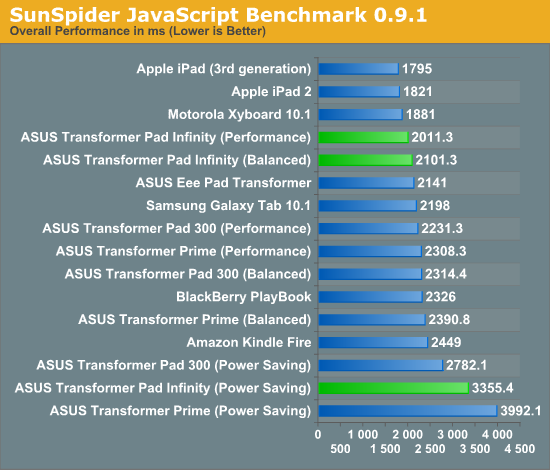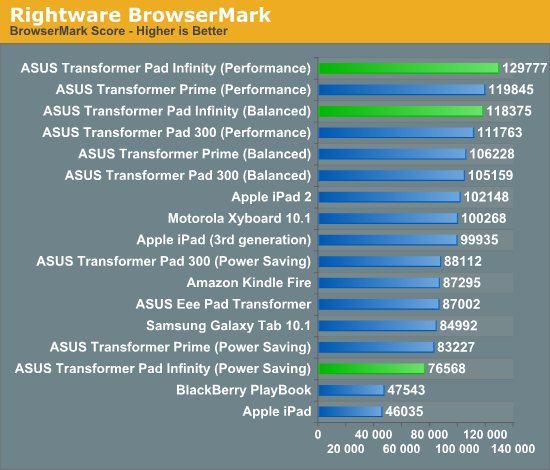ASUS Transformer Pad Infinity (TF700T) Review
by Anand Lal Shimpi on June 25, 2012 3:00 AM ESTA Faster Tegra 3, More Memory Bandwidth
As its new Android tablet flagship, ASUS selected the fastest Tegra 3 SoC NVIDIA is offering today: the T33. Architecturally similar to the rest of the Tegra 3 lineup, the T33 is simply a higher leakage part running at a higher voltage to hit higher clock speeds. Whereas the original T30 used in the Transformer Prime ran at a nominal voltage of 1.15V, the T33 runs at 1.237V. CPU clocks can now reach 1.7GHz with a single core active, or 1.6GHz otherwise.
| NVIDIA Tegra 3 | |||||||
| CPU Cores | Max CPU Clock (1 core active) | Max CPU Clock (multiple cores) | GPU Cores | Max GPU Clock | |||
| NVIDIA Tegra 3 (T33) | 4+1 | 1.7GHz | 1.6GHz | 12 | 520MHz | ||
| NVIDIA Tegra 3 (T30) | 4+1 | 1.4GHz | 1.3GHz | 12 | 520MHz | ||
| NVIDIA Tegra 3 (T30L) | 4+1 | 1.3GHz | 1.2GHz | 12 | 416MHz | ||
ASUS continues to expose control over the CPU governer through its Performance, Balanced and Power Saving modes exposed in ICS. In general, the balanced mode really does deliver nearly max performance (1.5 - 1.6GHz) while power saving significantly clamps CPU clock speeds (1GHz) and is more conservative with ramping up CPU clock to that max. Despite offering support for up to 1.7GHz operation, I typically saw 1.6GHz as a max even in performance mode.


The higher clocked CPU does deliver a tangible performance improvement over the Transformer Prime, and definitely over the original Transformer if you look at the BrowserMark results.
Although GPU clocks remain unchanged, in order to drive the higher resolution panel ASUS outfitted the Infinity with DDR3-1600. If I'm reading the part numbers on the DRAM devices used in previous models it looks like there's a significant increase in memory bandwidth this generation:
| ASUS Transformer Memory Choices | |||||
| TF Prime | TF Pad 300 | TF Pad Infinity | |||
| Memory Capacity | 1GB | 1GB | 1GB | ||
| Memory Type | DDR2-500 | DDR3-667 | DDR3-1600 | ||
| Memory Bandwidth | 2.0GB/s | 2.7GB/s | 6.4GB/s | ||
Remember NVIDIA's Tegra 3 only has a single channel memory interface, so frequency is the only option for increasing memory bandwidth. The increase in bandwidth does make scrolling and most UI interactions fairly smooth, although you will see dropped frames from time to time. I must say I'm fairly impressed by how well ASUS/NVIDIA were able to pull off smoothness without a significant hardware update. It's worth pointing out that the experience is far from perfect though. Even ICS is rough around the edges when it comes to delivering consistent UI performance on a tablet. Google is expected to address this with Jelly Bean but it's something to keep in mind for those buying in the near future. Granted by the time the Infinity is actually available, Jelly Bean may have already launched. As ASUS is widely expected to be a launch partner on Jelly Bean, I wonder if that means TF Pad Infinity owners will get a swift update.










112 Comments
View All Comments
xype - Monday, June 25, 2012 - link
"The colors and brightness and contrast are better on the TFP."The colors aren’t. Neither are the ppi. Something that actually makes a real impression in most situations—unless for some reason your only usage of a tablet is in bright sunlight.
The TPI and iPad 3—as hardware, only—each have their strengths and weaknesses. To claim one is absolutely better at everything just sounds fanboi-ish. Or, you know, astroturfer-ish (which you happily accuse others of being above).
joelypolly - Monday, June 25, 2012 - link
Sounds like someone is getting paid to Asus to say these things...zappb - Monday, June 25, 2012 - link
I thought this product was Vaporware considering it was annouced around Jan...and still not released but Awesome screen all the same - Look at those Contrast / white / black level numbers, haven't seen a screen like that in years...and at 1920x1200.When you look at the numbers, the significance of the screen has been glossed over in the article, - the only reason I can see for that, is perhaps that resolution sucks on Android, or apps don't scale well etc..
Lepton87 might have a point but the overall feel of the review is to wait for windows 8 tablets when perhaps the resolution will make more sense.
Cali3350 - Monday, June 25, 2012 - link
Your being very unfair. 1920*1080 is a great resolution and a big step up. But its not 25*18. That really IS big deal, its more than most 30 inch monitors. Your trying to equate a good improvement to a complete shift. Way to be objective yourself.sawilson - Monday, June 25, 2012 - link
I own them both. I can hold them side by side. It's really hardly noticable at all until you get the tablets closer than one would use them, and once again I'm talking about the prime versus my 32gb verizon 4g iPad that work gave me. I'm happily at work now typing this on my prime because it has completely replaced my Dell laptop running windows 7. The iPad could not do this. The only reason they went with a resolution that high is they have NO CHOICE. iOS is crippled and has to use multiples of the 6 year old iphone display resolution and dimensions. That's why it has a fail 4:3 display like an old television rather than a proper 16:10 display. That's why you have to buy all new apps for it instead of the superior Android solution that mimics what your laptop or pc and mac already do. Just scale things properly. There's no such thing as a "tablet optimized" app. That's marketing. That's apple attempting to justify failure in their mobile OS design by turning it into a positive. You can tell how intelligent a tech review is by looking for terms like "tablet optimized" or "fragmented" or "retina". It means they lack the technical knowledge to understand that's just marketing meant to talk around shortcomings in their own poorly designed device.LordConrad - Monday, June 25, 2012 - link
"That's why it has a fail 4:3 display like an old television rather than a proper 16:10 display."Tablets are designed primarily as consumption devices, which is how most people use them. For such a device, I find the 4:3 aspect ratio to be superior in most respects. Internet Browsing, email, and ebooks all look much better to me on tablets with a 4:3 aspect ratio. Gaming is a wash as I don't have a preference. The only drawback is watching movies as the black bars are larger unless you zoom-in.
I have nothing against Android, I actually prefer the openness of Android, but I much prefer the paper sized 4:3 aspect ratio for handheld tablets.
Lepton87 - Monday, June 25, 2012 - link
Anand is such a huge apple fanboy and it shows in his articles but it shoudn'tJunereth - Monday, June 25, 2012 - link
were we reading the same article here?xype - Monday, June 25, 2012 - link
Probably not. Anything short of "I ONLY HAVE SEX WITH MY ANDROID TABLET FROM NOW ON!!" under Final Words is seen as definitive proof of Apple-bias by some, it seems.Cyleo - Monday, June 25, 2012 - link
Before I owned the original TF Prime I was probably inclined to agree with you. However after 6 months of use, I can see Anand's point. Where iOS is polished in almost every possible way, Android is still rough around the edges. Browser performance on Android is excellent when it works, but it also hangs a lot. Engadget for example is a website that constantly brings my TFP's browser to its knees. And I can tell you that constantly force closing your browser is pretty annoying.There is a huge potential for Android tablet, but Asus and Google need to polish the user experience if they really want to compete with Apple.